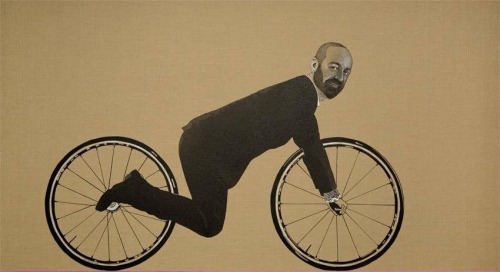
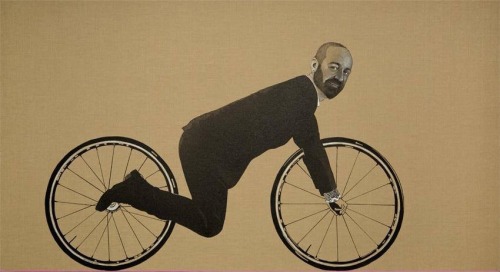
Khaled Takreti, Ca roule, acylic on canvas, 195 x 117cm.
Khaled Takreti began exhibiting in the mid 90s, though it was in the mid 2000s that he burst onto the scene in a big way, with his Pop-inspired portraits. With their swan-like necks and lithe fluid limbs, there was a touch of kinship with the elongated, elegant figures of Modigliani, while their striking, arresting gaze, gave them a gravitas that marked them as sumptuously urbane, contemporary social portraits. Based in Paris since 2006, the Beirut-born Syrian artist’s work has since encompassed monochromatic works as well as a shift from examining issues that are deeply personal and societal in a familial sense, to works that have been influenced by larger questions on conflict and war. In his most recent works, Takreti has returned his attention from the bigger picture of humanity to the very personal and human: the body itself, relishing the very act of life drawing and its ability to ground the artist in the present moment.
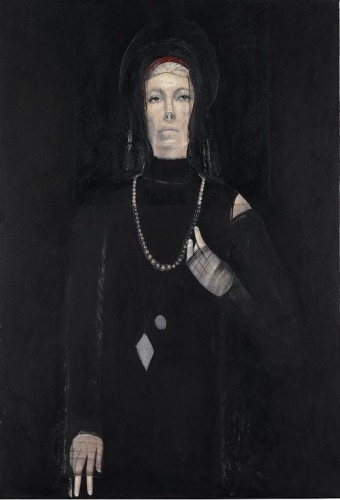
Khaled Takreti, Untitled, 2007, acrylic on canvas, 12 x 120 cm.
Your portraits of people often look directly at the viewer – how important is the gaze for you?
I am happy you asked this question, because I have always believed that the eyes – and the gaze specifically – are the key to determining a person’s psychological state. This was certainly among one of my first serious experiences when I exhibited at Atassi Gallery in Damascus in 1997. My show was about expression, and [my portraits] helped me eke out the secrets that a person may hold: be they joy sadness, shame, pain, death, life etc. All of these different expressions and emotions can be found in the human gaze.
Are there motifs you find yourself returning to again and again in your work, and if so, why?
The development of man from the inside pushes the artist to develop their work: this is what I am constantly striving for. However, we each have our own psychological issues that are impossible to overcome or avoid, no matter how sophisticated our mental abilities are. Freedom in general, that is, the human freedom to make personal choices, has been a topic that I have been interested in since my childhood, and it has found its self-expression in motifs such as the bicycle. By converting the human body to resemble a bike, I can explore the ultimate freedom of a bicycle – that is, a person – being launched into the air, unrestricted and unhindered by anything other than the rider who controls the pedals. For me. It is a symbol of mobility and expression. As for whether I revisit motifs – I finish a series of work when I can't find anything new to add to it. I don’t believe in repetition.
If you had to describe the evolution of your work over the last 10 years, how would you describe it? What has been the main change?
There has been a transformation from personal concerns to general ones, from exploring my family and its intricacies to more public subjects that are larger than all of us: war, death and freedom.
To become known for one big famous series of work (in your case, those Pop portraits), has this simply been great publicity and recognition or a hindrance?
I don’t think being known for my Pop-ish works has in any way been an impediment to my development, because there are important stages in my work and other series well before that, going back to the 1990s. At that time I was exploring issues of the family – and my family in particular, my grandmother and mother – and this was a subject that took me a decade to deal with. After that, I worked on other series that are equally well-known, dealing with the period of the Syrian war (the painting Balluchon was recently acquired by the National Museum of Immigration in Paris).
I would also posit that people are not always necessarily so fast to categorise or label, but I do think that sometimes artists themselves try to put themselves within a style in order to find a method by which they become known and that distinguishes them. There is also the temptation to guarantee financial security through marketing what is known and popular, leaving them not daring to distance themselves from this style, so they fall in the trap of repetition and place themselves within a box.
Honestly, I cannot classify the idea of being recognised for a particular series or work as a blessing or a curse because I personally never had this experience, as I like to deal and work with many things. I don’t believe in the idea of an artist having only one style. For example, Picasso went through many stages in his artistic career. Did that diminish his importance? Of course not. I think that an artist’s sincere spirit is what guides their accomplishment and that is enough to create an artistic world, regardless of the changes in subjects and styles. Ultimately, honest artistic expression that originates from the depth of one’s soul will also create a unique style.
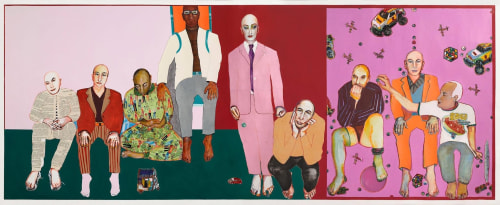
Khaled Takreti, Pop Couleurs - Les grands enfants, 2008, work on paper, 300 x 150 cm.
Why the decision to move to France?
This kind of decision I think is the result of years of thinking and preparation. I decided to travel and settle in France in 2004. I had been acquainted with Western cultures since my childhood and therefore the transition from East to West was very smooth. I did not find it difficult to adapt to the West, on the contrary, I was able to find my place in easily. To be able to preserve my Middle Eastern culture while also mixing between the two has been incredibly enriching for me personally and therefore my artistic experience.
How has this manifested in your work?
It has, of course, affected by identity. As I am a mixture of two rich cultures from East and West, but it has also had an important effect through the cultural scene it has made available to me. To be able to explore France’s visual culture through visiting important museums and exhibitions over these nearly 20 years has taught me to see better. By living abroad, I have learnt that everything is possible with art. Art is an expression of an artist and not a literal work, which was something of a controversial topic of debate between me and other Syrian artists before my departure.
What has been the effect of the Syrian conflict on your work – does living out of Syria give you more clarity to see the situation or does it create frustration? Is it important for you to process it through your work or is it too soon to tell?
The Syrian conflict has affected me as a human being and consequently (and inevitably) as an artist. Like most Syrians who have lived through the Syrian crisis from afar, we have experienced a long and difficult depression. I cannot judge what is more difficult – to live in war and see homes demolished and people die or to live abroad and be unable to go to your country to bury your own father who died during the war, and to live with a constant feeling of guilt for not returning.
I have tried to document the state of the war according to my own personal vision with large and numerous paintings almost since it started, but I think there are works that are not born yet. After war there is the afterwar; a generation of war and the consequences of it, and this is the part I have not yet lived through.
Let’s talk about your use of colour: how do you choose between the two palettes that appear in your work, vibrant colour or monochrome?
There is no rule for choosing colour, as it is directly linked to my psychological state and is therefore not a rational choice (except in rare cases and for specific reasons), and is how I best see how I want to address a subject.
What are you working on at the moment?
I am currently working on a series of large works on paper on the subject of the male and female body in a state of relaxation, and, as such, have been working with live models. I want to live in the present moment while drawing. I don't want to use my memory or documents during these periods of work. This desire to be in the moment – is it a consequence of war or is there no reason behind it at all? I don’t know, and I feel it is not really important to know why I want to live in the present, I just do.
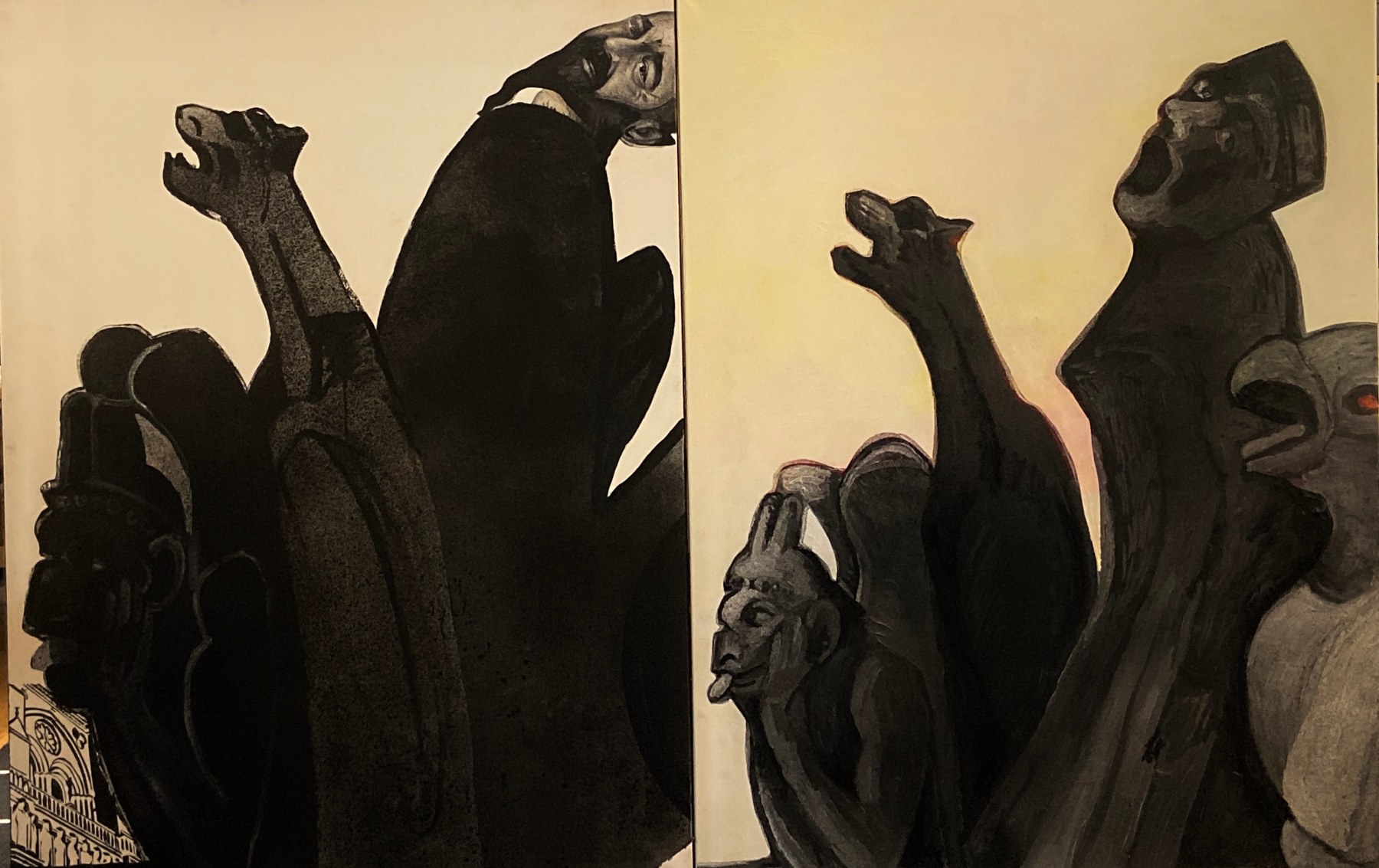
Khaled Takreti, Hommage pour la cathédrale Notre-Dame de paris, acrylic on canvas - diptyque, 130 x 97cm x 2, 194 x 130 cm.